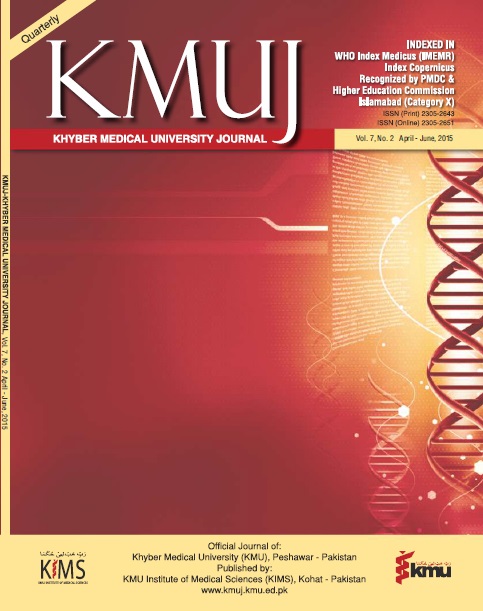A Study for Program Evaluation through Kirkpatrick’s Model
Main Article Content
Abstract
Objective:
This study was conducted to see the impact of teachers training program in medical institutions after conducting ten teacher’s training courses, each of seven modules spread over twenty-four days.
Methodology:
Kirkpatrick’s model was adopted to evaluate this program, which is considered to be best for such programs as it evaluates at four levels. The first level is immediate reaction of participants at the end of the course. Second, seeing the extent of learning, this is assessed through pre and post-module tests. The third level pertains to documenting transfer of acquired knowledge to students by trained teachers via structured proformas. The fourth level is seeing the overall impact of the training course which is evaluated by feedback obtained from students as well as teachers.
Results:
Results showed that immediately after completion of the course, 90% participants stated that they have benefitted from the course. However, the program evaluation months later showed that 40% of course participants showed improvement; 34% benefitted to a certain degree and 18% were affected to a lesser degree. Only 2% teachers claimed to have not benefitted from the course at all.
Conclusion:
The evaluation of training courses documents the enhancement of knowledge and teaching skills of the trained faculty. This helps in identifying gaps which can eventually be bridged by specially designed follow-up courses. Therefore, teachers training courses must be conducted and evaluated by every medical institute to achieve highest quality of medical education.
Article Details
Work published in KMUJ is licensed under a
Creative Commons Attribution 4.0 License
Authors are permitted and encouraged to post their work online (e.g., in institutional repositories or on their website) prior to and during the submission process, as it can lead to productive exchanges, as well as earlier and greater citation of published work.
(e.g., in institutional repositories or on their website) prior to and during the submission process, as it can lead to productive exchanges, as well as earlier and greater citation of published work.
References
REFERENCES:
Coble, C., &Koballa, T. (1996). Science Education. In J. Sikul, T.J. Butterly, & E. Guyton, Handbook of Research on teacher education, (PP.459-484). New York, NY: Simon and Schuster Macmillan.
Ramey-Gassert, L., &Shroyer, M.G (1992). Enhancing self efficacy in pre-service, elementary teachers. Journal of elementary science education, 4(1), 26-34.
Smith, D.C. (2000). Content pedagogical content knowledge for elementary science teache educators: Knowing our students. Journal of science teacher education, 11,27-46.
Ashton, P.T. (1984) Teacher efficacy: A motivational paradigm for effective teacher education. Journal of Teacher Education 35(5), 28-31.
University of Texas, Austin, Division of Instructional Innovation and Assessment (2007). Types of program evaluation.
Norcini JJ, Swanson DB,Grosso LJ, Shea JA, Webster GD. Reliability, validity and efficiency of multiple choice questions and patient management problem items formats in the assessment of Physician competence. Med Edu 1985; 19: 238-47.
Eva KW. (2005). What every teacher needs to know about clinical reasoning. Medical Education 39:98-106.
Sparks, G M (1988). Teacher’s attitudes toward change and subsequent improvement in classroom teaching. Journal of Education Psychology, 80(1), 111-117.
Stein, L.S. “The Effectiveness of Continuing Medical Education: Eight Research Reports”. Journal of Medical Education, 56 (February, 1981), 103-110.
Miller GE. The assessment of clinical skills / competence / performance Acad Med 1990; 65:563-67.
Mennin, S.P. Program Evaluation in Medical Education (workshop text). 3rd Turkish Medical Education Congress April 12-16, 2004, Sanliurfa, Turkey
Kirkpatrick’s 1998 book “Evaluating Training Programs: The four Levels” http://www.kirkpatrickpartners.com/
Margery H. Davis and Ronald M. Harden (2003) Planning and Implementing an undergraduate medical curriculum: the lessons learned, Medical teacher, Vol. 25, No.6, 2003,pp.596-608.
Cavanaugh. S(1993) Connecting Education and practice, in: L Curry, J. Wergin& Associates (Eds) Educating professionals: Responding to New Expectations for competence and Accountability, pp107-125 (San Fransisco, Jossey Bay).
Neufled VR, Norman GR. Assessing clinical competence, vol 7. New york: Springer, 1985.
Yvonne Steinert, Louise Na smith and Norma Daigle (2003) – Executive Skills for medical faculty: a workshop description and evaluation – Medical Teacher, Volume.25, No-6-2003.
Van der Vleuten, C.P.M..Scherpbier. A.J.J. A.. Dolmans. D. H. J. M..Schuwirth. L.W.T..Verwijnen. G.M..&Wolfhagen, H.A. P. (2000). Clerkship assessment assessed. Medical Teacher, 22(6), 592-600.
Worthen, B.R. and James R Sanders, 1987. Educational Evaluation: Alternative approaches and practical Guidelines. New York: Longman.
Rossi, P.H. LIpsey, M.W. & Freeman, H.E. (2004)
Evaluation: A systematic Approach
